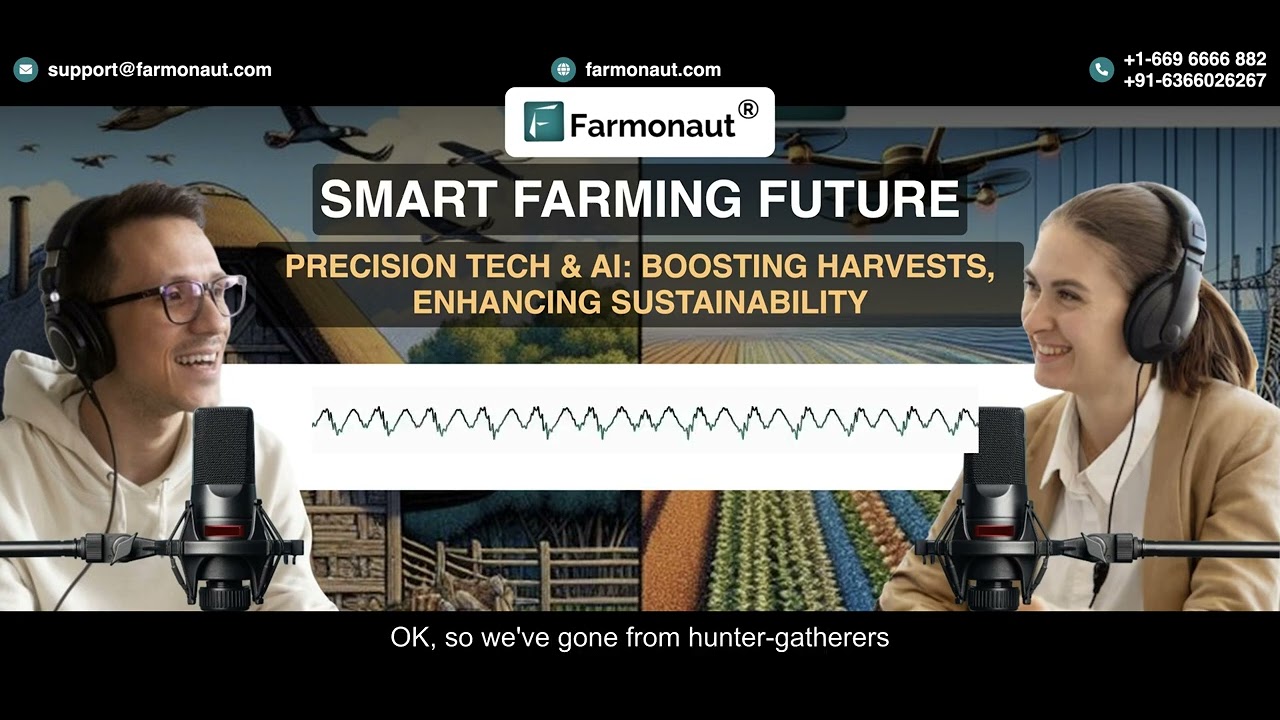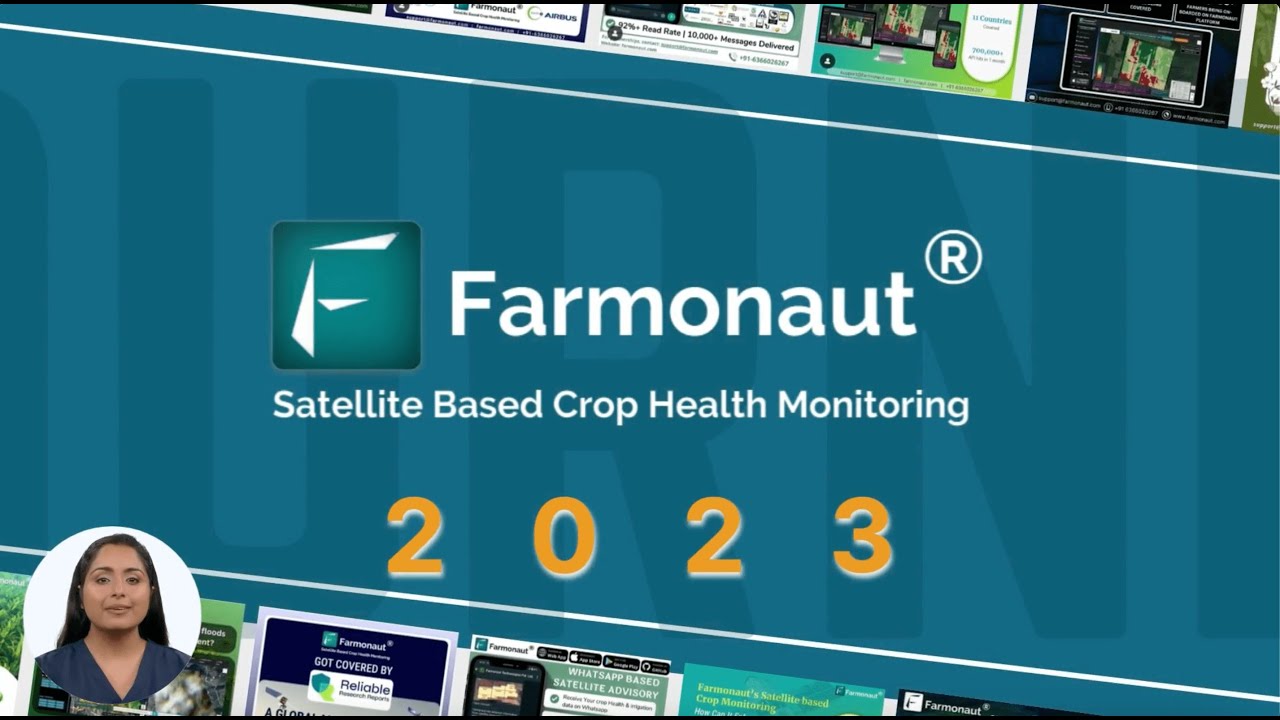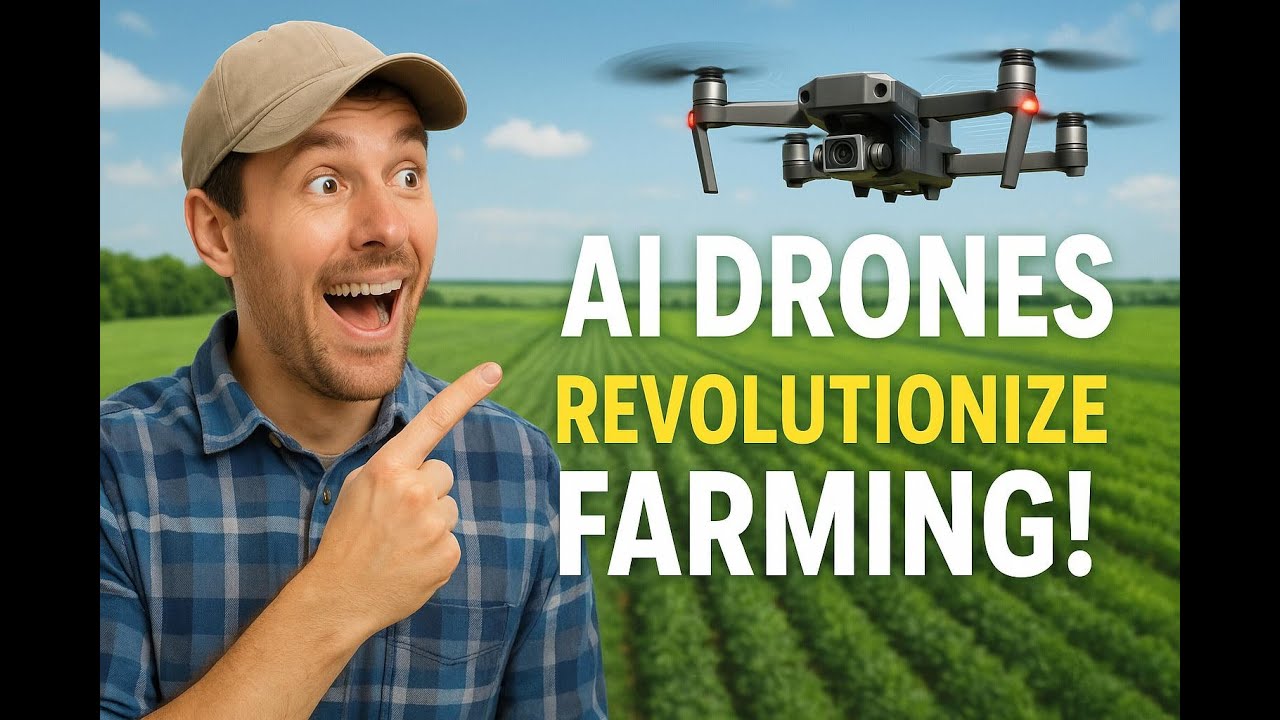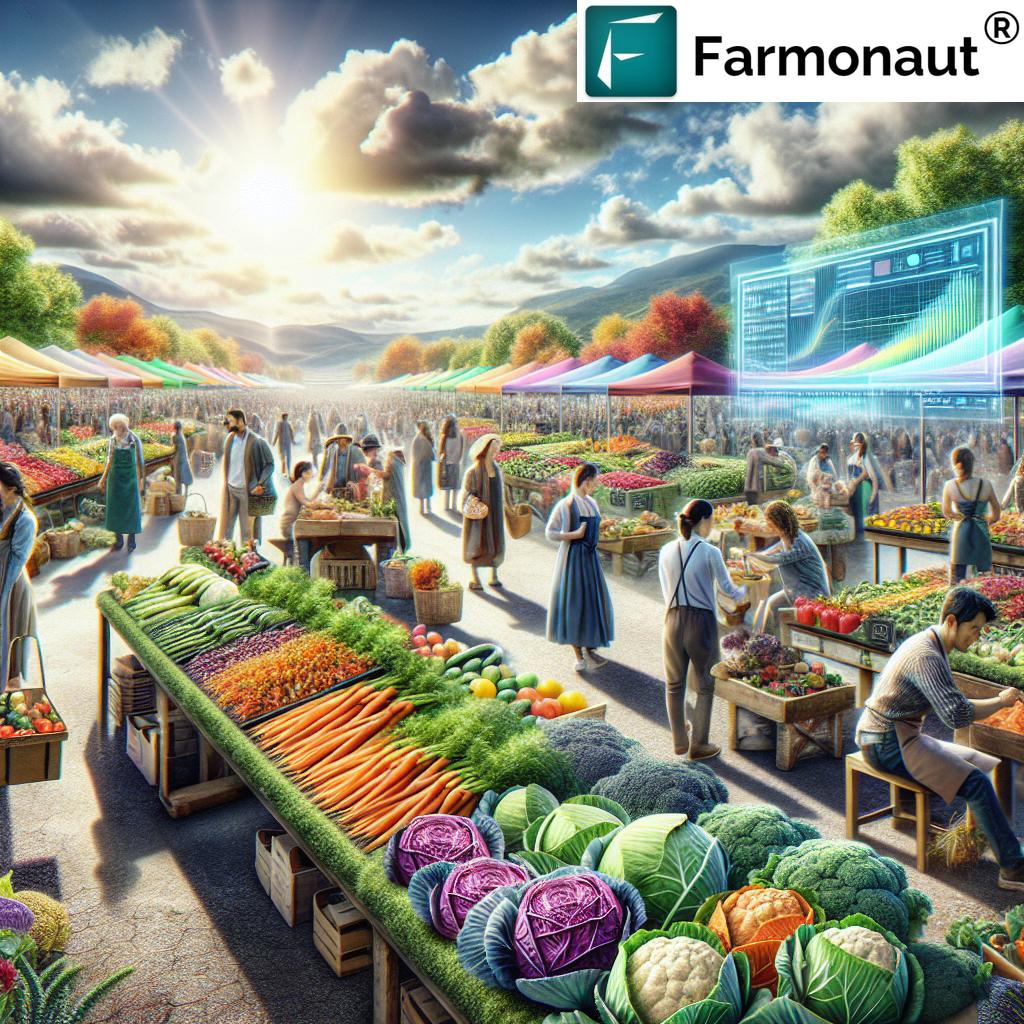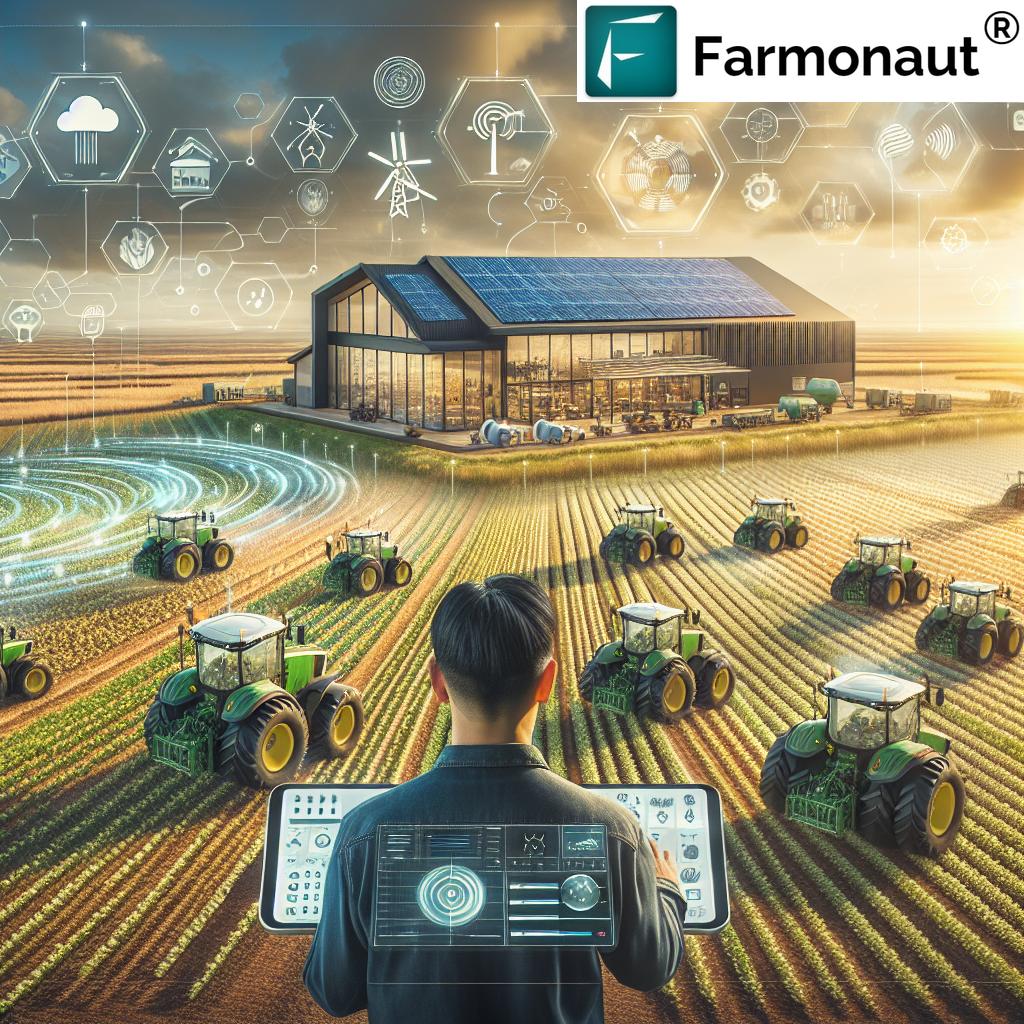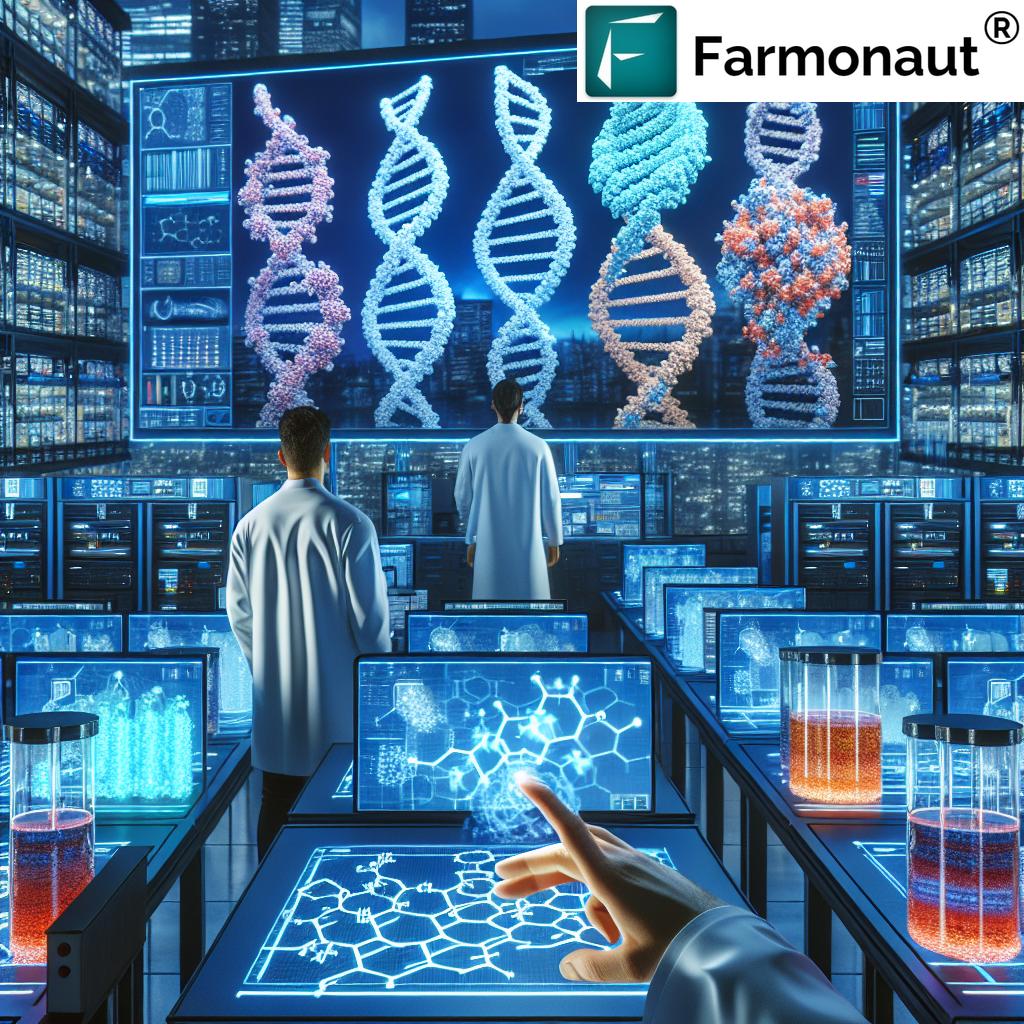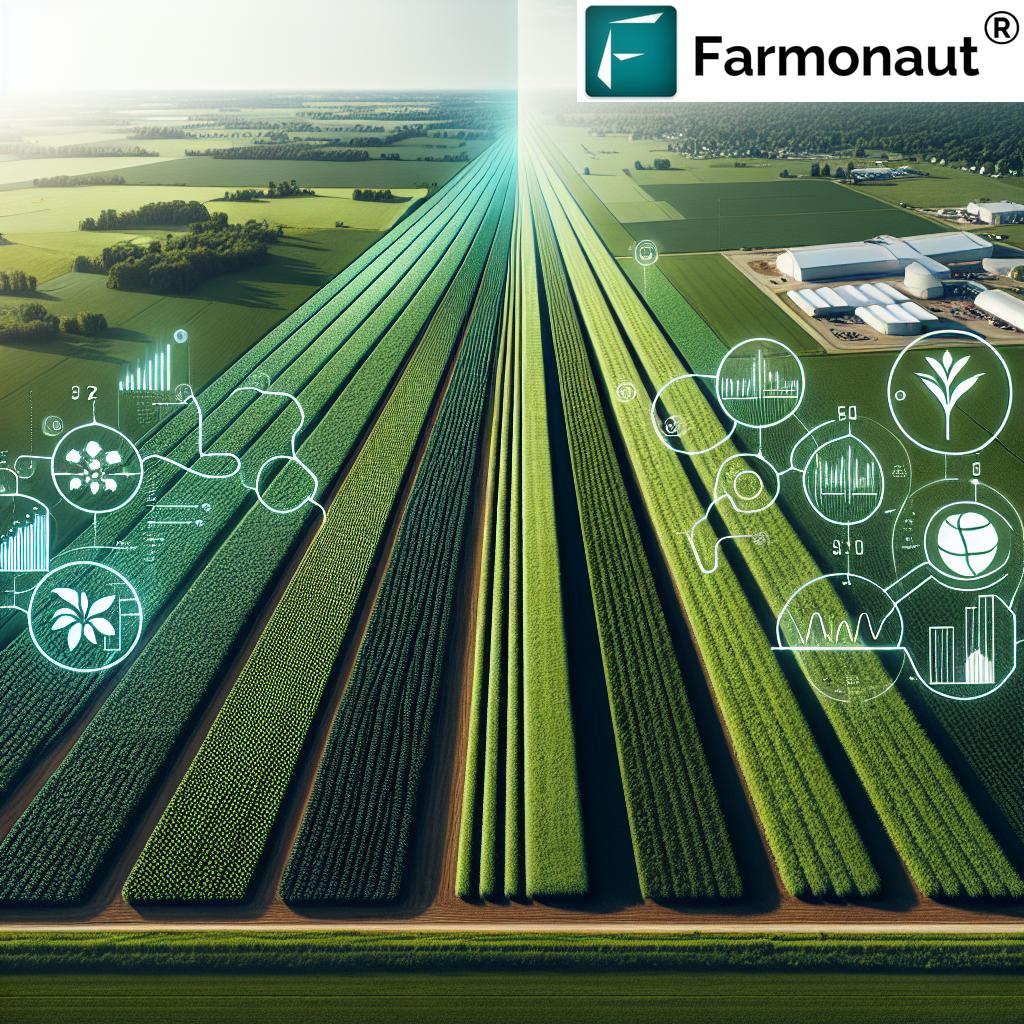AI Boosts Employment in US Agriculture & Manufacturing 2025: Employment Changes, Tariff Impacts, and the Future Workforce
- Trivia Highlights
- Introduction
- Impact of Tariffs on US Manufacturing and Agriculture Employment
- Employment Trends in US Agriculture and Manufacturing Sectors
- Agriculture Manufacturing: Bridging Sectors and Accelerating Innovation
- The Transformative Role of AI in Agriculture
- The Rise of Smart Farming Technologies & Data-Driven Innovation
- Comparison Table: Employment Changes and AI Adoption (2024 vs. 2025)
- Farmonaut’s Technological Edge in the Era of AI Agriculture
- A Global Perspective: Employment in Agriculture Sector in India
- 2025 and Beyond: The Future of Employment, Skills & Policy
- Farmonaut Solutions: Empowering a Skilled Workforce and Sustainable Agriculture
- FAQs: AI, Employment & Agriculture in 2025
- Conclusion
“AI-driven roles in US agriculture and manufacturing are projected to increase by 18% between 2023 and 2025.”
Introduction: Unveiling Employment Changes in US Manufacturing and Agriculture Sectors Post-Tariff Implementation
The era following key trade policy shifts and tariff implementation in the United States has driven significant, far-reaching employment changes in US manufacturing and agriculture sectors post-tariff implementation.
These sectors have not only adapted to tariff-imposed supply dynamics, but have also undertaken rapid technological adoption, notably the implementation of AI in agriculture and manufacturing.
In 2025, we find that employment patterns, workforce demands, and skill requirements have evolved dramatically, painting a complex picture that is reshaped by both trade policies and new technologies.
This industry news article explores the latest trends,
highlighting:
- The impact of tariffs and supply chain disruptions on jobs
- How AI and advanced manufacturing open new opportunities, roles, and skills
- Changes in the employment landscape—from traditional labor to data and tech jobs in both sectors
- A global perspective: A nod to employment in agriculture sector in India and the worldwide trajectory of ag-tech innovation
We also present a comprehensive comparison table of employment numbers and AI adoption rates, and provide practical, industry-focused insights for 2025 and beyond.
Impact of Tariffs on US Manufacturing and Agriculture Employment
The late 2010s and early 2020s witnessed the imposition of tariffs on a range of imports, particularly steel, aluminum, and other critical goods.
The intention was aimed at curbing imports, boosting domestic production, and ultimately protecting domestic jobs in key sectors like manufacturing, including agriculture manufacturing.
- Initial Prospects: Some subsectors, like steel and heavy machinery, saw a short-term recovery and creation of jobs due to decreased foreign competition.
- Increased Input Costs: However, higher tariffs led many manufacturers to face increased input costs for materials and components, directly impacting production costs.
- Supply Chain Disruptions: Reliance on global supply chains meant these costs and related disruptions rippled across industries—slowing demand, production, and manually operations.
- Mixed Employment Gains: While protective policies led to gains in some areas, the overall effects were mixed; certain industries dampened hiring, and job creation was limited.
Yet, a “silver lining” emerged within agriculture manufacturing.
Being a segment responsible for the production of equipment, machinery, fertilizers, pesticides, and food processing tools, it witnessed a relative improvement in employment trends.
This sector benefited from shifts toward:
- Modernization of equipment and technologies
- Increased domestic demand for advanced farming machinery
- Growth of the service and maintenance workforce required to sustain technological expansion
Key takeaway: Tariffs and supply chain shifts created both disruption and opportunity. The focus and adoption of new technology accelerated, especially within domestic agriculture manufacturing and related service segments.
Employment Changes in US Manufacturing and Agriculture Sectors Post-Tariff Implementation
The employment landscape across manufacturing and agriculture in the United States has undergone a paradigm shift in the post-tariff era.
The convergence of global market forces, tariff-induced price volatility, and the implementation of AI in agriculture and manufacturing has brought about this transformative change.
Agriculture: From Manual Labor to Skilled, Tech-Driven Roles
- Traditional Roles: Classic farm labor, such as manual fieldwork, has declined, reflecting a broader shift driven by labor shortages, aging workforce, and economic realities.
- Skilled, Tech-Based Roles: AI-powered systems, precision agriculture, and smart tools have redefined the skill set—demanding expertise in:
- Data analysis
- Software usage
- Operation and maintenance of advanced equipment
- Pivot Toward Efficiency: Even as some crop producers faced export volatility, most have invested in tools and innovation—from satellite-based crop monitoring to AI-driven irrigation.
Manufacturing: Evolution Under the Pressures of Global Supply Chains
- Specific Recoveries: Sectors directly shielded by tariffs (like certain metals and heavy machinery) recovered, adding jobs in the short term.
- Broad Challenges: Most manufacturers, however, faced increased input costs. Many integrated automation and AI systems to counter rising costs, reshaping workforce demands.
- Changing Workforce Dynamics: There’s heightened demand for engineers, robotics specialists, IT professionals, and those with AI skills.
- Service & Maintenance: The maintenance of more complex, technologically-advanced equipment also stimulated new job creation, especially for those with hybrid skills in technology and machinery.
Summary: Both sectors show clear movement away from low-skill, manual, and repetitive labor roles toward tech-driven, skilled positions. This shift requires not only new training and education models, but also the active adoption of tools supporting workforce transition and adaptability.
“Post-tariff, 42% of US manufacturers report workforce shifts directly linked to AI adoption and automation.”
Agriculture Manufacturing: Bridging Sectors and Accelerating Innovation
The agriculture manufacturing segment stands at the intersection of
adoption and production, uniquely linking manufacturing and agriculture. The sector’s evolution post-tariffs has seen:
- Production of Smart Machinery & Equipment:
- Autonomous tractors
- Drones and aerial monitoring systems
- IoT-based soil and crop sensors
- Software-integrated planters and harvesters
- Innovations in fertilizer, pesticide, and input processing equipment
- Role Expansion:
- Robotics engineers, software developers, data scientists, and technical maintenance professionals are in high demand, reflecting the advanced requirements of modern equipment.
- These roles blend traditional manufacturing knowledge (metalworking, mechanical assembly) with digital and AI-based expertise.
- Growth in Ag-tech Startups:
- Entrepreneurs and startups, inspired by the ongoing shifts, are developing new hardware and software solutions in partnership with established manufacturers.
- This is spurring job creation and innovation across rural and urban US geographies.
The agriculture manufacturing sector essentially bridges the supply and demand of tech talent, industrial production, and agricultural efficiency, catalyzed by the rapid adoption of AI, robotics, and digital tools.
The Transformative Role of AI: Implementation of AI in Agriculture and Its Impact on Employment
The implementation of AI in agriculture in 2025 stands as the most transformative force affecting not just yields and efficiency, but the very structure of the workforce.
How AI is Changing the Game
- Automated Decision-Support: AI-based advisory platforms use data from satellites, sensors, and machinery to optimize planting schedules, fertilizer usage, and pest control.
- Crop Health Monitoring: Drones, satellites, and AI vision systems identify disease, pest outbreaks, or water stress before they escalate, allowing for precision interventions.
- Resource Management: AI optimizes irrigation and pesticide application, reducing waste and environmental impact.
- Yield Forecasting & Market Analytics: Machine learning models predict future crop yields and commodity prices, enabling better market participation and logistics planning.
Employment Impacts: Job Losses and Gains
- Displacement of Manual Roles: Many low-skilled, repeatable manual labor positions are being phased out, as automation and AI can handle repetitive monitoring and management tasks.
- Creation of Tech-Driven Roles: Employment is shifting toward AI system operators, drone technicians, precision agriculture advisors, data scientists, and software specialists—all requiring advanced training.
- Service, Maintenance, and Support: Every AI-powered or digital system employed requires setup, fine-tuning, troubleshooting, and regular hardware/software support.
- Upskilling Demand: Large investments in training, upskilling, and educational reforms are now required to transition agricultural workers into hybrid tech roles.
The bottom line: The implementation of AI in agriculture is not just a technological trend—it’s a foundational workforce shift that’s reshaping employment patterns in the US and globally.
The Rise of Smart Farming and Data-Driven Decision Making
2025 marks a significant leap for smart farming in the United States. Technologies that combine artificial intelligence, real-time satellite imagery, IoT devices, and cloud-based software are rapidly becoming standard, not exceptions.
- Satellite Technology: Frequent, high-resolution, and multispectral images now enable crop monitoring at scale, soil moisture detection, and disaster impact assessment.
- IoT & Precision Equipment: Connected sensors gather data on soil, climate, and crop conditions; autonomous machines apply inputs with pinpoint accuracy.
- Cloud & Mobile Platforms: Platforms—like those by Farmonaut—empower even small- and medium-scale operators to access, analyze, and act on data via mobile apps and web interfaces.
This revolution in technology adoption means that today’s agricultural workers and manufacturers need to be comfortable with both the physical and digital.
Briefly, these are the tools and platforms (such as Farmonaut’s satellite monitoring app) that wind up democratizing access to advanced insight-driven farming.
Farmonaut API and Developer Access
For enterprises and developers aiming to integrate satellite and AI-powered agricultural insights, the Farmonaut API provides direct programmatic access.
Enhance your own agri-applications with real-time data, mapping, and resource management functions!
Detailed guidance is available in our Developer Documentation for faster, smarter integration into your systems.
Farmonaut Tools for Carbon Footprinting, Traceability, Crop Insurance & Loans
- Decarbonize your agriculture practices with Farmonaut Carbon Footprinting—track, analyze, and report field-level emissions to stay sustainable and meet regulatory requirements.
- Streamline supply chain transparency using Farmonaut Traceability for blockchain-based verification of food and agri-products, fostering trust from farm to fork.
- Access and verify crop loans or insurance with satellite-powered monitoring on our Crop Loan & Insurance solution—empowering agri-businesses and financial institutions with accurate field data and reduced fraud risks.
- Manage large agri-fleets efficiently through Fleet Management—minimize operational costs, improve vehicle safety, and monitor all agriculture equipment centrally.
- Sustain and plan at scale using Large Scale Farm Management—tailored for administrators and managers of extensive operations needing real-time, geo-tagged monitoring and advisories.
Comparison Table: Employment Changes and AI Adoption Rates in US Agriculture & Manufacturing (2024 vs. 2025)
To provide a clear, data-driven perspective on the employment changes in US manufacturing and agriculture sectors post-tariff implementation, and the implementation of AI in agriculture, the following table presents a side-by-side comparison highlighting key sectoral trends.
| Sector | Employment (2024, estimate) | Employment (2025, estimate) | AI Adoption Rate (2024, estimate) | AI Adoption Rate (2025, estimate) |
|---|---|---|---|---|
| Agriculture | ~2,450,000 | ~2,575,000 | 28% | 41% |
| Manufacturing (Total, incl. Agri. Mfg.) | ~12,480,000 | ~12,995,000 | 25% | 44% |
Key Insights:
- Employment increased modestly but shifted dramatically in skill requirement and sectoral distribution.
- AI adoption rose sharply in both sectors,* with agriculture manufacturing and supply chain-adjacent services leading growth.
Farmonaut’s Technological Edge in the Era of AI Agriculture and Manufacturing
In this moment of transition and opportunity for employment in agriculture and manufacturing, leveraging real-time data and advanced insight has never been more critical.
We at Farmonaut provide affordable satellite-based monitoring, AI-driven advisory systems, blockchain traceability, and robust fleet and resource management platforms—all accessible by web or mobile app, or seamlessly integrated via API.
Our goal is to help users across the agriculture, manufacturing, infrastructure, and mining sectors transition into the digital age with clarity, productivity, transparency, and sustainability.
Some of our unique platform capabilities include:
- Real-time, multispectral satellite imagery for crop, resource, and asset monitoring
- AI-based weather and yield forecasting, farm operation advisories, and tailored strategies
- Blockchain tools for supply chain and crop traceability
- Fleet and carbon emission management for compliance and cost savings
All these features support workforce reskilling, new tech-driven job opportunities, and better resource management, crucial for meeting changing employment and industry needs in 2025 and beyond.
A Global Perspective: Employment in Agriculture Sector in India
The US is not alone in experiencing tech-driven workforce changes. India, with one of the world’s largest and most diverse agriculture labor bases, offers a unique global perspective on these transitions.
- Employment in agriculture sector in India remains primarily dependent on manual labor, yet trends are shifting.
- AI and advanced manufacturing technologies are slowly but inevitably making their mark, from government-led “smart village” initiatives to private ag-tech startups introducing more accessible equipment and digital platforms.
- Labor patterns are evolving: The percentage of the workforce engaged in low-skill, traditional farming is declining as technology intervention offers better efficiency and higher incomes for skilled operators and managers.
- The path taken in India reflects similar trends echoing across the United States and other agricultural economies worldwide, albeit at a varied pace and scale.
These international patterns only reinforce the importance of workforce reskilling, technological adoption, and inclusive policies for a sustainable, competitive agricultural future.
2025 and Beyond: The Future of Employment, Skills & Policy
It is clear that employment in US agriculture and manufacturing sectors post-tariff implementation is shaped not by a single trend, but by the interaction of global market forces, rapid technology shifts, and evolving policy landscapes. What can industry, government, and workers expect in the years ahead?
- Continued AI Integration: AI adoption rates will keep increasing, especially in precision farming, logistics, and equipment manufacturing, elevating the role of skilled, hybrid workforce.
- Reskilling and Upskilling: Massive investments in training are critical. Education providers must coordinate with industries to develop programs in data science, mechatronics, digital agronomy, and more.
- Policy Interventions: Governments will need to update labor and trade policies to balance job protection with the opportunities of technological advancement—flexible safety nets and digital inclusion initiatives are already being piloted.
- Sustainability and Environmental Tracking: Environmental mandates (emissions, water use, etc.) will increasingly demand accurate monitoring, as available through carbon footprint tracking tools and satellite-based compliance platforms.
- Smarter Supply Chains: Blockchain traceability and digital resource tracking will become universal—tackling food safety, supply chain fraud, and input authenticity.
In summary, the focus for 2025 and beyond should be on proactive innovation adoption, smart policy, and workforce adaptability.
Farmonaut Solutions: Empowering a Skilled, Sustainable Workforce Across Sectors
As we look at the shifting landscape of employment in agriculture and manufacturing sectors in the US and globally, we at Farmonaut are committed to empowering this workforce transition.
- Our satellite imagery and AI advisory platform delivers affordable, actionable insights for farms and businesses, supporting smarter, data-driven operations—even for those without prior tech experience.
- Real-time environmental monitoring and carbon tracking help businesses stay compliant, reduce emissions, and support sustainability goals.
- With fleet and resource management, even large, multi-location operations are streamlined—bringing cost efficiency and risk reduction to traditional machinery operators evolving into tech managers.
- Our blockchain-based traceability ensures that food safety, input authenticity, and supply chain transparency are within reach for every participant—from farm to manufacturer to retailer.
- Programmers and business users can innovate on top of Farmonaut’s infrastructure using our API platform or by deploying on our large-scale, scalable monitoring systems.
- For financial workflow optimization in agriculture, our Crop Loan & Insurance products provide secure, accurate verification options, reducing fraud and speeding up credit flows, particularly relevant in volatile markets.
All our solutions are designed for individual users, businesses, governments, and institutions—providing flexibility, transparency, and cost-effectiveness as global industry changes intensify.
FAQs: Employment Changes, AI Adoption, and Agriculture Trends in 2025
Q1. What are the main employment changes in US manufacturing and agriculture sectors post-tariff implementation?
A: The main changes are a shift away from low-skill, manual roles toward skilled positions in technology, data analysis, machinery operation, and AI system management. There’s also a modest rise in employment, but more significant is the change in skill requirements and the emergence of hybrid technology-labor roles.
Q2. How has the implementation of AI in agriculture affected the job market?
A: AI leads to displacement of some manual labor roles but simultaneously generates new opportunities for AI technicians, precision farming consultants, system integrators, and software/data specialists. In turn, this requires tailored upskilling programs and new career pathways in both agriculture and manufacturing.
Q3. What roles are most in demand in agriculture manufacturing in 2025?
A: Roles such as robotics engineers, AI specialists, IoT integration experts, drone operators, and equipment service/maintenance technicians are seeing high demand.
Q4. How do trends in employment in agriculture sector in India compare with those in the US?
A: India’s agriculture sector remains labor-intensive, but adoption of AI and mechanization is on the rise. The pace of change is slower than in the US, but both countries are moving toward a model where tech and data skills are increasingly critical for agricultural work.
Q5. What is the role of Farmonaut in supporting these global workforce shifts?
A: Farmonaut provides affordable satellite-based insights, AI-driven advisory tools, blockchain traceability, and fleet/resource management solutions. These empower workers and businesses to operate more efficiently, make data-driven decisions, and transition to a technology-focused future in agriculture and manufacturing.
Conclusion: Charting a Future of Opportunity, Innovation, and Skilled Growth
In 2025, employment changes in US manufacturing and agriculture sectors post-tariff implementation illustrate a complex yet hopeful transition. The intersection of changed tariff policies, global supply chain restructuring, and the implementation of AI in agriculture and manufacturing is reshaping the workforce for the better.
While protective policies protected select jobs, it is innovation—especially the adoption of advanced AI systems and smart agriculture manufacturing—that is creating a new class of skilled jobs. Across both the US and global markets like India, the challenge now is
- Ensuring all workers have access to training and upskilling resources,
- Embracing digital and data-driven decision-making,
- Utilizing satellite and AI technology to maximize productivity sustainably,
- And building inclusive policies that support both economic growth and social well-being.
The future of employment in agriculture, manufacturing, and related sectors is inextricably tied to the adoption of AI and smart technologies—not as competitors to human labor, but as essential tools for empowerment, upskilling, and broad-based prosperity.
For advanced, affordable, and accessible solutions that drive this future forward, visit our web and mobile apps, try our APIs, and discover how we, at Farmonaut, are powering the next workforce transformation in agriculture and beyond.






